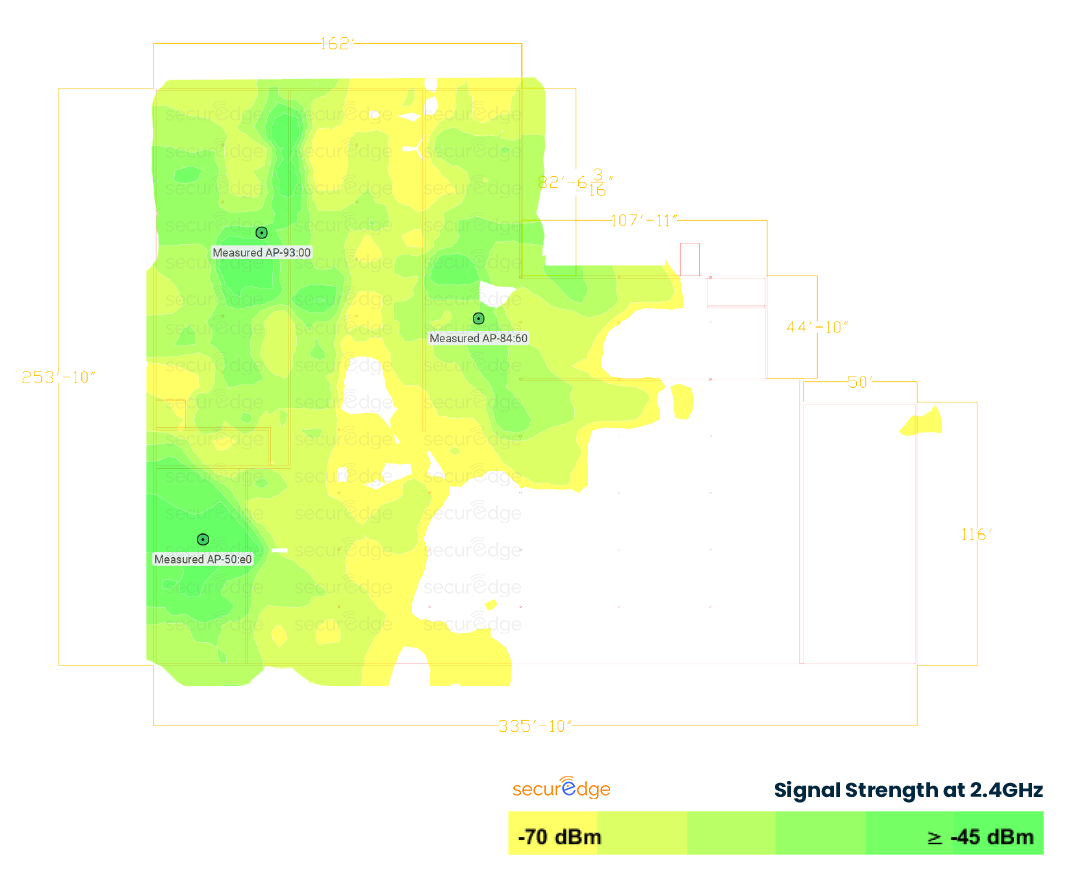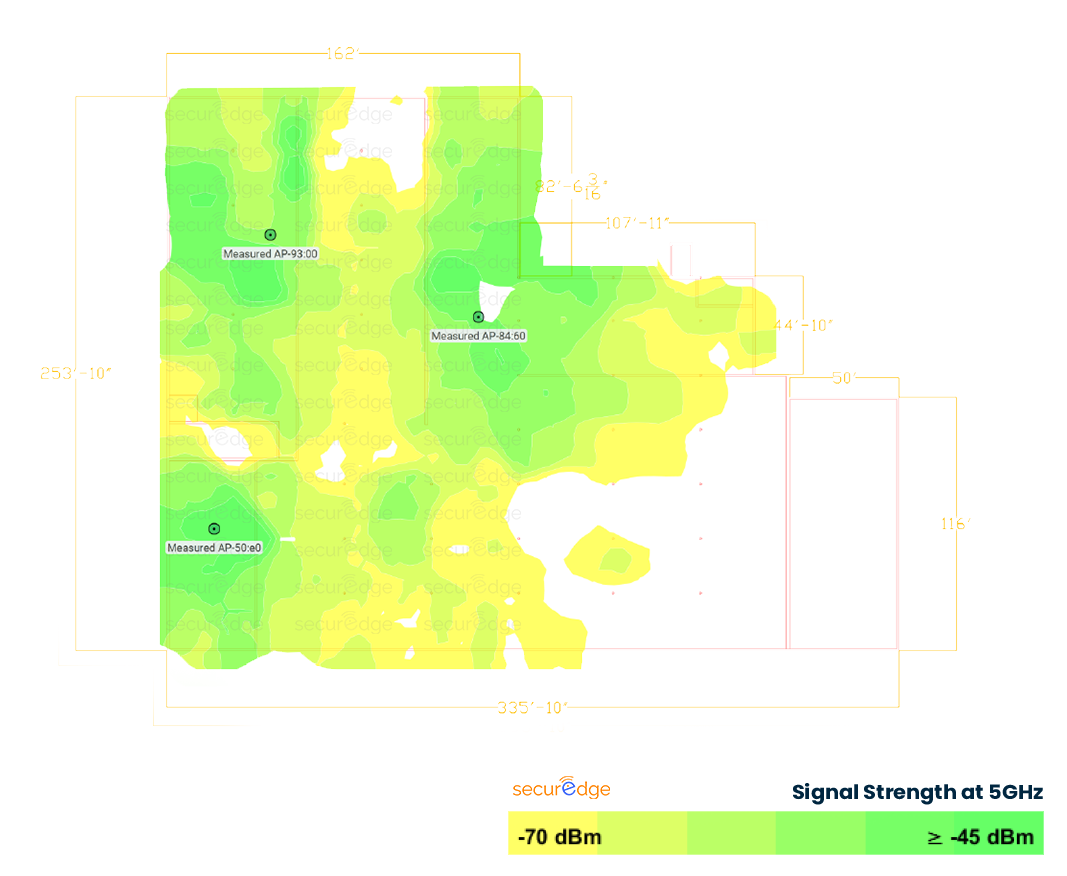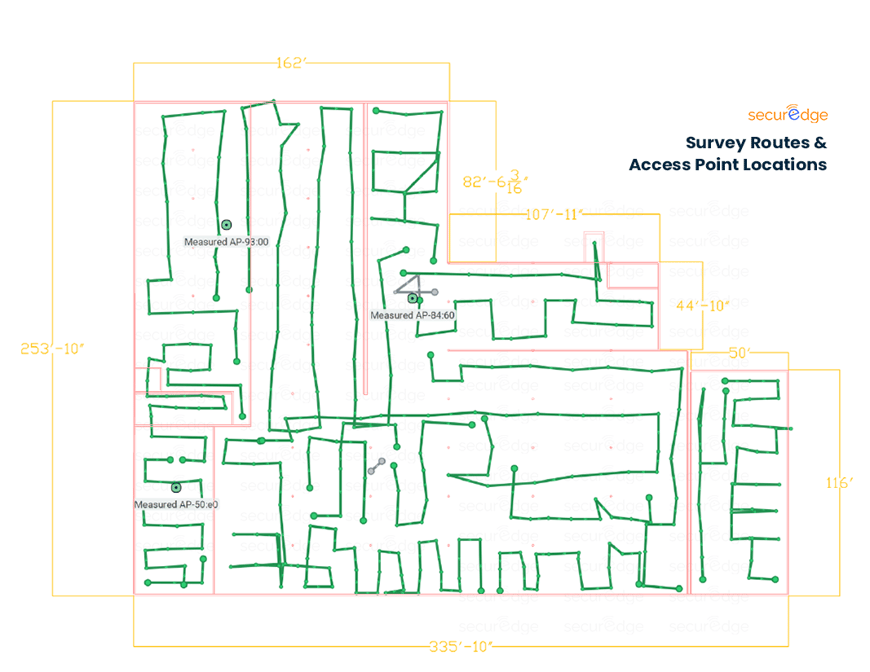All businesses today that are planning to deploy or refresh their wireless networks need to start by scheduling a site survey—and for a good reason.
Site surveys allow network engineers to identify areas of RF coverage and the equipment necessary to deliver the required signal level at a given location.
Without it, planning an enterprise-grade WiFi network becomes challenging, if not impossible, causing several common problems such as:
-
Coverage holes
-
Excessive interference
-
Incorrect types and amounts of access points
-
Wasted time and money
This article doesn't list every detail in the WiFi design process.
Instead, it lists the starting point we use at SecurEdge when planning a new network. It's the starting point we've successfully completed thousands of times across a variety of environments.
In other words, it's proven to work.
In this blog, you'll learn what the different types of site surveys are and how to use each one.
1 . Start with a Predictive Site Survey
What is it?
A predictive site survey, also known as a predictive WiFi design, uses advanced software from companies like Ekahau, to model your environment and create different types of WiFi heat maps. It establishes what’s required to deploy a high performing WLAN system and approximately how much it will cost.
Typically, building floor plans are loaded into predictive site survey software to develop a wireless network design.
Predictive site survey tools will account for building materials, square footage, number of end-users, types of applications, antenna models, and other variables to provide a reliable predictive wireless plan for your site or facility.
Below are RF heat maps showing the signal strength for both the 2.4 GHz and 5 GHz bands. These are some of the more common reports included with each type of site survey:
 From our experience, this software has become very accurate, generating a margin of error within 10%. It is easily accounted for and gives you an incredible view of the specified environment.
From our experience, this software has become very accurate, generating a margin of error within 10%. It is easily accounted for and gives you an incredible view of the specified environment.
One of the most significant advantages of a predictive site survey is its cost and time effectiveness. However, the key to producing these types of results is to have as much information as possible.
We recommend using floor plans or building blueprints and factoring in information about the types and amounts of devices and types of applications.
When should it be used?
A predictive site survey is perfect for most environments today. Even in high-density areas, we can produce optimal results when having the right software, amounts of information, and enough experience.
Predictive site surveys are best when deploying WiFi for the first time at a given location or refreshing an existing network.
Below is a detailed list of services that come with a predictive WiFi design:
- RF Coverage Design - Design software will visualize the predicted delivery of RF signals across the facility or campus from designed AP locations.
- RF Capacity Design - Survey software will simulate and identify potential RF capacity for the intended coverage area(s).
- RF Channel Power Design - Design will include an RF channel and power level layout for the coverage areas.
- Wired Network Architecture - Design will consist of a wired switch design with details per MDF/IDF of required switching to support wireless access points.
- Predictive WiFi Design Summary Report - Documentation including predictive WiFi heat maps, infrastructure components.
For more complex environments such as medical, industrial, and educational locations, another type of site survey is better suited.
2. If Required, Validate On-Location with a WiFi Site Survey
What is it?
Like it’s predictive counterpart, a WiFi site survey is a service that establishes what’s required to deploy wireless coverage at a given location.
However, it takes this process a step further by combining a predictive site survey with an on-location visit from a network engineer.
Things like interference (noise) can be measured on-site, whereas a predictive design obviously can’t do that. A WiFi site survey can identify any devices that may be causing interference and pinpoints its location to verify a proper wireless design.
We also have software to simulate wireless VoIP and streaming media to make sure they will work seamlessly in your environment.
So, with a WiFi site survey, you start with a predictive design and then validate those results by surveying the AP locations at the building or buildings where you are deploying WiFi coverage.
For example, in a warehouse or manufacturing facility, this will entail elevating the survey rig (8-13 ft tripod with a mounted access point and battery) to the installation height of the proposed access points. The network engineer will do this for every AP location recommended in the predictive design.
Below is a map of the actual route a network engineer walked during a WiFi site survey. This map also indicates the access point locations in the specific environment:
A WiFi site survey also uses both laptop devices and tablets to understand RF propagation from both “high end” and “low end” devices.
When should it be used?
As we stated earlier, this type of service is perfect for planning new WiFi deployments or network refreshes in more complex environments.
Complexity usually encompasses high-density environments, applications that roam from AP to AP and apps that tend to be latency-sensitive. For example, RTLS in hospitals, wireless video surveillance, and multi-media over wireless.
Typically these include multi-building campuses, medical and industrial facilities, and any locations that require maximum redundancy and performance capabilities.
Below is a detailed list of services that come with a WiFi site survey:
- Everything included with a WiFi Design - Predictive (PLUS)
- Spectrum Analysis - Analysis provides detection and identification of existing RF emitters along with interferers: WiFi and non-Wi-Fi.
- Performance Analysis - Analysis includes throughput testing of data traffic from the client perspective.
- RF Signal Strength (RSSI), data rates, SNR, co-channel interference (CCI), latency, and client roaming performance will also be measured.
- Capacity Analysis - Analysis includes documentation of detected channels, channel widths, and AP density.
Getting Started
Enterprise-grade wireless networks don’t just happen by accident; they take a lot of experience and science to create optimal results.
So, whether you’re deploying WiFi at a new location or refreshing an existing network, one or possibly both of these types of site surveys are the best way to get started.
If you’re ready to schedule a site survey today or you have some questions about an upcoming project, please click the link here to get started.
*This blog post was originally posted in January of 2015 and has been completely revamped and improved for accuracy and thoroughness.



